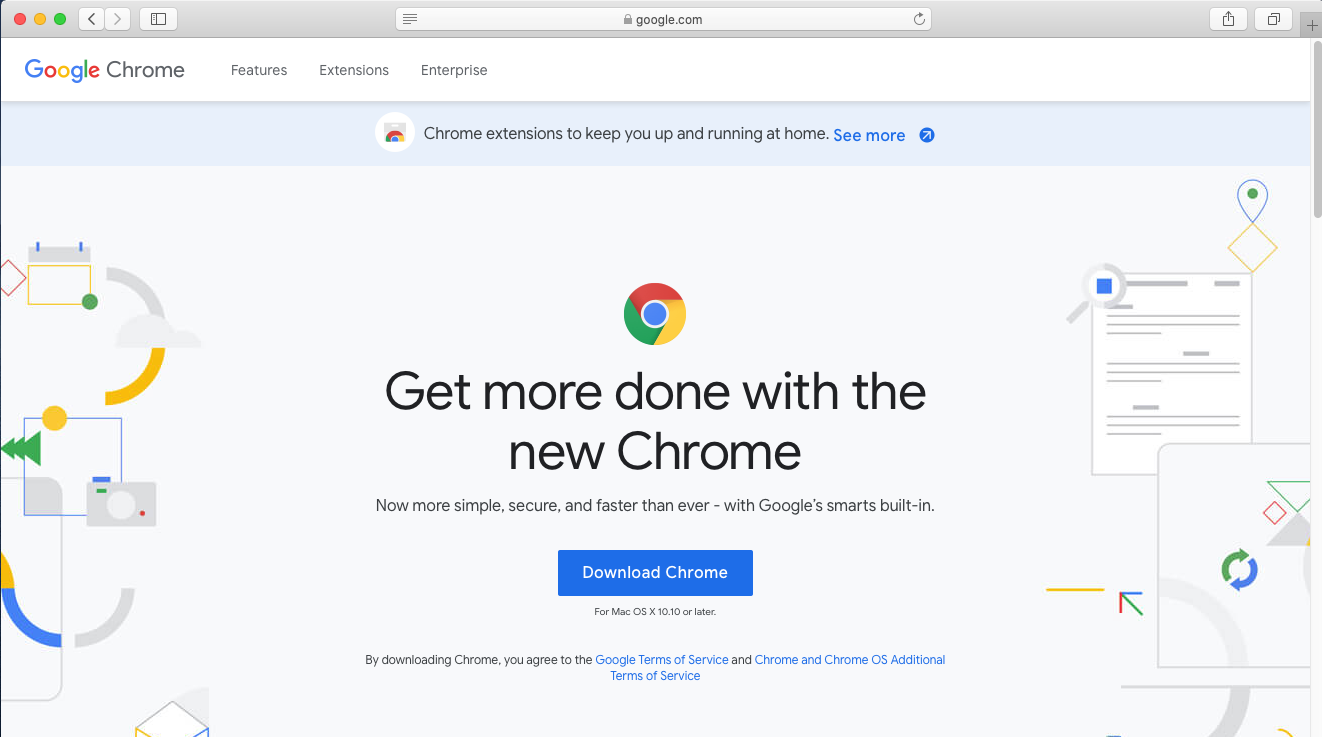Chrome on MacOS Catalina is especially persnickety when it comes to (self-signed) certificates, due in part, I believe, to Apple’s new certificate requirements for macOS 10.15 (Catalina) and iOS 13.
Having recently upgraded to MacOS Catalina, things seemed fine. Then, I was recreating a local testing server self-signed TLS certificate, and Chrome was NOT happy. Where I would have normally expected an warning about a self-signed certificate, and an option to “Proceed to test.DOMAIN”, I was instead faced with a very different warning:
Learn the detailed Chrome (Mac) problems and solutions to fix slow Chrome on Mac (Google Chrome not working on Mac) now. Device Battery Drains Fast. Chrome is famous for having fast performance. And fast performance means it gets to use a lot of Mac’s CPU resources compared to other browsers. The higher the CPU usage, the faster.
- When the Chrome for Mac download is finished, open the file called googlechrome.dmg and go through the installation process Drag the Chrome icon to the Applications folder when asked — the last step before you finally have Chrome on Mac Launch Google Chrome from Applications or straight from your Dock.
- Jun 15, 2020 Apparently, this is also the case for those experiencing graphics issues on the Google Chrome macOS Catalina version. This is after the update to macOS 10.15.4, where users are seeing horizontal blue lines on the screen. I have a MacBook Pro 16″ running MacOS Catalina 10.15.4 (19E266) and this is what occasionally happens to me.
NET::ERR_CERT_INVALID
host.domain normally uses encryption to protect your information. When Google Chrome tried to connect to host.domain this time, the website sent back unusual and incorrect credentials. This may happen when an attacker is trying to pretend to be host.domain, or a Wi-Fi sign-in screen has interrupted the connection. Your information is still secure because Google Chrome stopped the connection before any data was exchanged.

You cannot visit host.domain right now because the website sent scrambled credentials that Google Chrome cannot process. Network errors and attacks are usually temporary, so this page will probably work later.
“Scrambled credentials”? Really? Someone was having fun with words, but that is untrue, and very unhelpful. In fact the certificate was a perfectly valid, albeit self-signed, certificate. Though, as it turns out, Apple instituted some new requirements on all TLS certificates for macOS 10.15 and iOS 13, the upshot of which is that even self-signed certificates issued after July 1st, 2019 must have the Subject Alternative Name (=DNS:<CN>) and Extended Key Usage (=id-kp-serverAuth) extensions. A more detailed read of some of this is also available from Daniel Nashed.
I was able to test certificates without those two extensions under Chrome, Firefox, and Safari on macOS Catalina (10.15), Mojave (10.14), Ubunutu 18.04, and Windows 10. The really interesting part is of all those combinations, only Chrome on Catalina gives an error that cannot be bypassed by a typical “Proceed anyway/I accept the risks” button. That’s despite the apparent use by Chrome of Apple’s certificate validation and storage (via the macOS KeyChain) of certificates and exceptions. Safari on Catalina still gives the “self-signed” error with a “proceed anyway” option; Chrome does not.


Aside:Chrome includes an secret bypass keyword if you type thisisnotsafe (previously badidea) into the browser error window. That bypasses the certificate error, adding the typical exception which can be reset using the “reenable warnings” by viewing the certificate for a given webserver.
If you still can’t get a real signed certificate (such as free ones via LetsEncrypt), then this snippet will generate a “properly configured” certificate, albeit still self-signed, that complies to Apple’s new restrictions:
Or, with a older OpenSSL/LibreSSL (such as default version on macOS), replace with with:
NOTE: Security of your certificate (and key) are your responsibility. The above example is for illustration purposes and generates a key with no passphrase. YOU take all responsibility for any use or mis-use of that code-fragment or the certificate/key-pair it generates.
You can see the additional extensions in the generated certificate:
When loaded, Chrome now gives it’s typical “self-signed certificate” warning, which states:
NET::ERR_CERT_AUTHORITY_INVALID

This server could not prove that it is host.domain; its security certificate is not trusted by your computer’s operating system. This may be caused by a misconfiguration or an attacker intercepting your connection.
“Proceed to host.domain (unsafe)”

If, instead, you get a slightly different variant complaining about HSTS:
Download Google Chrome For Mac Catalina
NET::ERR_CERT_AUTHORITY_INVALID
You cannot visit host.domain right now because the website uses HSTS. Network errors and attacks are usually temporary, so this page will probably work later.
Google Chrome For Mac Catalina
… that’s because you probably have an older, or just different, certificate cached by Chrome. Use the chrome://net-internals/#hsts page to query/delete entries for your host.domain. In Safari, you may have to simply clear all history, or get into the weeds with Jeff Geering See also this for Firefox.
Install Google Chrome For Mac
With thanks to other posts as well:
Google Chrome For Mac Catalina Download
- https://serverfault.com/questions/845766/generating-a-self-signed-cert-with-openssl-that-works-in-chrome-58
- https://security.stackexchange.com/questions/74345/provide-subjectaltname-to-openssl-directly-on-the-command-line
- https://stackoverflow.com/questions/37035300/how-to-determine-the-default-location-for-openssl-cnf
